CAT DILR Questions – Download DILR CAT Questions PDF
By BYJU'S Exam Prep
Updated on: September 13th, 2023

CAT DILR Questions are an integral part of the syllabus as the DILR is a separate section asked in the exam. There were 20 CAT DILR Questions asked in CAT 2022 exam. The DILR Questions in CAT consist of topics from both Data Interpretation and Logical Reasoning. The CAT authorities do not release any official syllabus for DILR; however, for ease of understanding the CAT DILR Questions, we can divide the syllabus of this section into two sections: DI and LR.
The Data Interpretation topics of CAT consist of questions on tables, caselets-based DI, graphs, scatter plots, bubble charts, and Venn diagrams. The Logical Reasoning CAT questions consist of questions on games and tournaments, team formations, order and ranking, binary logic, and arrangements. To ensure productive preparation and sufficient practice, BYJU’S Exam Prep experts have mentioned all the details of CAT DILR Questions and a few sample questions related to this.
Table of content
CAT DILR Questions are an integral part of the syllabus as the DILR is a separate section asked in the exam. There were 20 CAT DILR Questions asked in CAT 2022 exam. The DILR Questions in CAT consist of topics from both Data Interpretation and Logical Reasoning. The CAT authorities do not release any official syllabus for DILR; however, for ease of understanding the CAT DILR Questions, we can divide the syllabus of this section into two sections: DI and LR.
The Data Interpretation topics of CAT consist of questions on tables, caselets-based DI, graphs, scatter plots, bubble charts, and Venn diagrams. The Logical Reasoning CAT questions consist of questions on games and tournaments, team formations, order and ranking, binary logic, and arrangements. To ensure productive preparation and sufficient practice, BYJU’S Exam Prep experts have mentioned all the details of CAT DILR Questions and a few sample questions related to this.
What are DILR Questions in CAT?
Data Interpretation and Logical Reasoning questions are commonly known as as DILR. It is one of the most important sections in CAT and other MBA Exams. The CAT DILR Questions test of critical thinking and analytical abilities of the candidates. The section consists of questions on multiple topics such as graphs, caselets, charts, diagrams, clocks & calendars, and arrangements, to name a few.
The difficulty level of the DILR questions in CAT generally ranges from moderate to tough. Not only the questions are of higher difficulty level, but they are also often tricky and time-consuming. In the last year, a total of 20 CAT DILR Questions out of the 14 MCQs and 6 TITA Questions. Preparing for DILR Questions for CAT can be tricky as there is no specific theory or formulae that you can refer to.
Types of CAT DILR Questions
The DILR Questions in CAT consist of topics such as Tables, Graphs, Games and Tournaments, Caselets, etc. The various types of CAT DILR Questions are on:
- Tables
- Data Caselets- Reasoning-Based DI
- Column Graphs
- Bar Graphs
- Venn Diagrams
- Line Charts
- Pie Charts
- Scatter Plot
- Bubble Chart
- Routes and Network Radar Chart
- Binary Logic
- Games and Tournaments
- Arrangements
- Team Formation
- Order and Ranking
DILR Practice Questions For CAT
Aspirants preparing for the CAT exam must be aware of the types of CAT DILR questions. Our experts have curated a few DILR questions which appeared in the previous year CAT Exam.
Instructions: Answer the questions based on the information given below:
Ten musicians (A, B, C, D, E, F, G, H, I, and J) are experts in at least one of the following three percussion instruments: tabla, mridangam, and ghatam. Among them, three are experts in tabla but not in mridangam or ghatam, another three are experts in mridangam but not in tabla or ghatam, and one is an expert in ghatam but not in tabla or mridangam. Further, two are experts in tabla and mridangam but not in ghatam, and one is an expert in tabla and ghatam but not in mridangam.
The following facts are known about these ten musicians.
1) Both A and B are experts in mridangam, but only one of them is also an expert in tabla.
2) D is an expert in both tabla and ghatam.
3) Both F and G are experts in tabla, but only one of them is also an expert in mridangam.
4) Neither I nor J is an expert in tabla.
5) Neither H nor I is an expert in mridangam, but only one of them is an expert in ghatam.
Q- Who among the following is DEFINITELY an expert in tabla but not in either mridangam or ghatam?
- H
- A
- F
- C
Answer – A
Solution:
From statement i, exactly one of A or B is an expert in only mridangam, and the other one is an expert in tabla and mridangam but not ghatam.
From statement ii, D is the only person who is an expert in tabla and ghatam but not mridangam.
From statement iii, one of F and G is an expert in only tabla, while the other is an expert in tabla and mridangam but not ghatam.
From statements iv and v, I is not an expert in tabla and mridangam; hence, I is an expert in only ghatam.
From statement v, H is not an expert in mridangam. Hence, the only possibility left is that H is an expert in only tabla.
From statement iv, J is not an expert in tabla. Hence, he must be an expert in only mridangam.
For the remaining two persons C and E, one should be an expert in only tabla, while the other should be an expert in only mridangam.
Using this data, we can get the Venn diagram as given below:
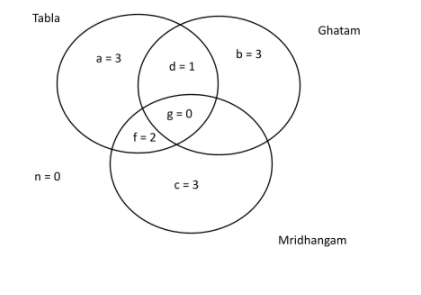
Regions:
a = G/F, H, C/E; b = I, c = A/B, C/E, J; d = D; f = A/B, G/F
From the above venn diagram, we can see that H is definitely an expert in tabla but not in mridangam or ghatam.
Q.Who among the following is DEFINITELY an expert in mridangam but not in either tabla or ghatam?
- J
- B
- G
- E
Answer -A
Solution:
From statement i, exactly one of A or B is an expert in only mridangam, and the other one is an expert in tabla and mridangam but not ghatam.
From statement ii, D is the only person who is an expert in tabla and ghatam but not mridangam.
From statement iii, one of F and G is an expert in only tabla, while the other is an expert in tabla and mridangam but not ghatam.
From statements iv and v, I is not an expert in tabla and mridangam; hence, I is an expert in only ghatam.
From statement v, H is not an expert in mridangam. Hence, the only possibility left is that H is an expert in only tabla.
From statement iv, J is not an expert in tabla. Hence, he must be an expert in only mridangam.
For the remaining two persons C and E, one should be an expert in only tabla, while the other should be an expert in only mridangam.
Using this data, we can get the Venn diagram as given below:
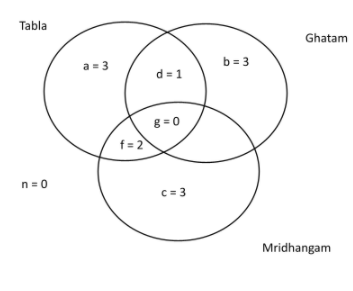
Regions:
a = G/F, H, C/E; b = I, c = A/B, C/E, J; d = D; f = A/B, G/F
J is definitely an expert in mridangam but not in tabla or ghatam.
Q-Which of the following pairs CAN NOT have any musician who is an expert in both tabla and mridangam but not in ghatam?
A.C and E
- A and B
- C and F
- F and G
Answer- A
Solution:
From statement i, exactly one of A or B is an expert in only mridangam, and the other one is an expert in tabla and mridangam but not ghatam.
From statement ii, D is the only person who is an expert in tabla and ghatam but not mridangam.
From statement iii, one of F and G is an expert in only tabla, while the other is an expert in tabla and mridangam but not ghatam.
From statements iv and v, I is not an expert in tabla and mridangam; hence, I is an expert in only ghatam.
From statement v, H is not an expert in mridangam. Hence, the only possibility left is that H is an expert in only tabla.
From statement iv, J is not an expert in tabla. Hence, he must be an expert in only mridangam.
For the remaining two persons C and E, one should be an expert in only tabla, while the other should be an expert in only mridangam.
Using this data, we can get the venn diagram as given below:
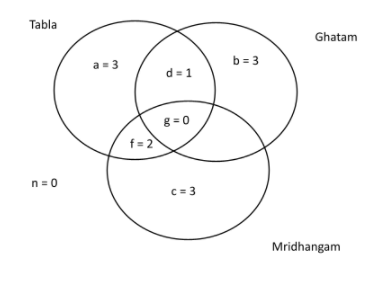
Regions:
a = G/F, H, C/E; b = I, c = A/B, C/E, J; d = D; f = A/B, G/F
Neither C nor E is an expert in both tabla and mridangam but not in ghatam.
Q.If C is an expert in mridangam and F is not, then which are the three musicians who are experts in tabla but not in either mridangam or ghatam?
A.E, G, and H
- C, E, and G
- E, F, and H
- C, G, and H
Answer- C
Solution:
From statement i, exactly one of A or B is an expert in only mridangam, and the other one is an expert in tabla and mridangam but not ghatam.
From statement ii, D is the only person who is an expert in tabla and ghatam but not mridangam.
From statement iii, one of F and G is an expert in only tabla, while the other is an expert in tabla and mridangam but not ghatam.
From statements iv and v, I is not an expert in tabla and mridangam; hence, I is an expert in only ghatam.
From statement v, H is not an expert in mridangam. Hence, the only possibility left is that H is an expert in only tabla.
From statement iv, J is not an expert in tabla. Hence, he must be an expert in only mridangam.
For the remaining two persons C and E, one should be an expert in only tabla, while the other should be an expert in only mridangam.
Using this data, we can get the Venn diagram as given below:
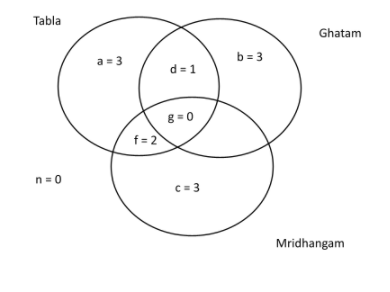
Regions:
a = G/F, H, C/E; b = I, c = A/B, C/E, J; d = D; f = A/B, G/F
So, E, F, and H are the three musicians who are experts in tabla but not in either mridangam or ghatam.
Direction: The multi-layered pie-chart below shows the sales of LED television sets for a big retail electronics outlet during 2016 and 2017 . The outer layer shows the monthly sales during this period, with each label showing the month followed by the sales figure of that month. For some months, the sales figures are not given in the chart. The middle-layer shows quarter-wise aggregate sales figures (in some cases, aggregate quarter-wise sales numbers are not given next to the quarter). The innermost layer shows annual sales. It is known that the sales figures during the three months of the second quarter (April, May, June) of 2016 form an arithmetic progression, as do the three monthly sales figures in the fourth quarter (October, November, December) of that year.
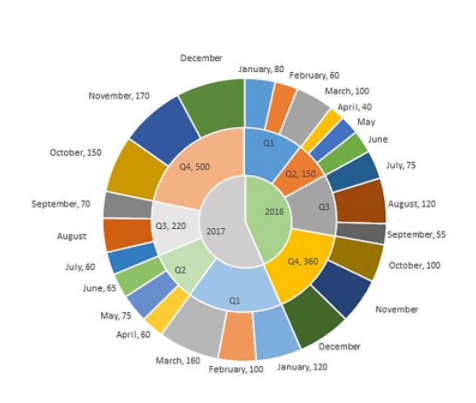
Q-What is the percentage increase in sales in December 2017 as compared to the sales in December 2016?
- 22.22
- 28.57
- 38.46
- 50.00
Answer: B
Solution:
It is given that the sales figures during the three months of the second quarter (April, May, June) of 2016 form an arithmetic progression. So, 40 + (40 + a) + (40 + 2a) = 150
Hence, a = 10.
Sales: April 2016 = 40, May 2016 = 50, June 2016 = 60
The same case holds for October, November, and December of 2016. 100 + (100 + b) + (100 + 2b) = 360
Or b = 20
Sales: October 2016 = 100, November 2016 = 120, December 2016 = 140
August 2017 = 220 – 130 = 90.
Similarly, sales for December 2017 = 500 – 320 = 180
We can obtain the following table:
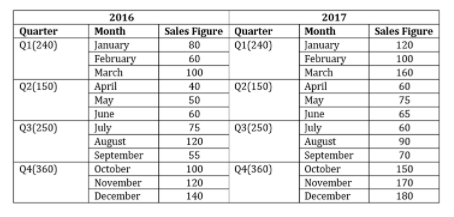
Sales in December 2017 = 180
Sales in December 2016 = 140
Required percentage increase = (40/140)×100 = 28.57%
The correct option is B.
Q- In which quarter of 2017, was the percentage increase in sales from the same quarter of 2016 the highest?
A.Q1
B.Q2
C.Q3
D.Q4
Answer: A
Solution:
It is given that the sales figures during the three months of the second quarter (April, May, June) of 2016 form an arithmetic progression. So 40 + (40 + a) + (40 + 2a) = 150
Hence, a = 10.
Sales: April 2016 = 40, May 2016 = 50, June 2016 = 60
The same case holds for October, November, and December of 2016. 100 + (100 + b) + (100 + 2b) = 360
Or b = 20
Sales: October 2016 = 100, November 2016 = 120, December 2016 = 140
August 2017 = 220 – 130 = 90.
Similarly, sales of December 2017 = 500 – 320 = 180
We can obtain the following table:

The following table shows the percentage increase in sales in 2017 for the same quarter of 2016.

Hence, we can say that in Q1 the percentage increase in sales was the highest.
The correct option is A.
Q. During which quarter was the percentage decrease in sales from the previous quarter’s sales the highest?
A.Q2 of 2016
- Q1 of 2017
- Q2 of 2017
- Q4 of 2017
Answer: C
Solution:
It is given that the sales figures during the three months of the second quarter (April, May, June) of 2016 form an arithmetic progression. So 40 + (40 + a) + (40 + 2a) = 150
Hence, a = 10.
Sales: April 2016 = 40, May 2016 = 50, June 2016 = 60
The same case holds for October, November, and December of 2016. 100 + (100 + b) + (100 + 2b) = 360
Or b = 20
Sales: October 2016 = 100, November 2016 = 120, December 2016 = 140
August 2017 = 220 – 130 = 90.
Similarly, sales of December 2017 = 500 – 320 = 180
We can obtain the following table:

Solving the question by calculating the options, we get:
→Q2 of 2016
=((150−240)/240) ×100= −37.5% increase or 37.5%% decrease
→Q1 of 2017
=((380−360)/360)×100= 5.55% increase.
→Q2 of 2017
=((200−380)/380)×100 = −47.36 or 47.36%% decrease
→Q4 of 2017
There is an increase from 220 to 500.
So, sales of Q2 of 2017, had the highest percentage decrease compared with Q1 of 2017.
The correct option is C .
Q-. During which month was the percentage increase in sales from the previous month’s sales the highest?
A.March of 2016
- October of 2016
- March of 2017
- October of 2017
Answer: D
Solution:
It is given that the sales figures during the three months of the second quarter (April, May, June) of 2016 form an arithmetic progression. So 40 + (40 + a) + (40 + 2a) = 150
Hence, a = 10.
Sales: April 2016 = 40, May 2016 = 50, June 2016 = 60
The same case holds for October, November, and December of 2016. 100 + (100 + b) + (100 + 2b) = 360
Or b = 20
Sales: October 2016 = 100, November 2016 = 120, December 2016 = 140
August 2017 = 220 – 130 = 90.
Similarly, sales of December 2017 = 500 – 320 = 180
We can obtain the following table:

Solving the question by calculating the options, we get:
→ March 2016
=((100−60)/60) ×100= 66.67% increase
→October 2016
=((100−55)/55)×100= 81.81% increase.
→March 2017
=((160−100)/100)×100 = 60% increase
→October 2017
=((150−70)/70)×100 = 114.2% increase
So, sales of October 2017 compared with September 2017, had the highest percentage increase of 114.2%.
The correct option is D.
CAT DILR Questions PDF
Candidates can download the DILR Questions PDF from the link below. Our Experts have curated sample CAT DILR Questions for aspirants to help them in their CAT Preparation.
☛ Download CAT DILR Questions PDF
How to Prepare DILR Questions in CAT?
As the difficulty level of CAT DILR Questions is Moderate to difficult, candidates should know the strategies to solve these questions accurately. In order to ace the CAT DILR Questions, we have shared some tips which the candidate needs to remember:
- Know the DILR Syllabus: In order to have a command of the CAT DILR Questions, the candidate needs to know the CAT Syllabus for the DILR section completely. Once the candidates are aware of the DILR Syllabus, they will know the types of CAT DILR Questions that can be asked.
- Solve Past Year Papers: Past year papers are the best reference point for the CAT candidate to understand the level of difficulty of the paper. Candidates should attempt the CAT Previous years Questions Paper to understand the pattern, types and difficulty level of CAT DILR Questions.
- Attempt Mock Tests: In order to analyze the preparation level, the candidates must attempt the CAT Mock Tests. The mock tests will give the candidate an idea about their weak areas of CAT DILR Questions. Candidates can thereby work on their weak areas and rectify their mistakes. Mock tests will also give the candidates a real exam-type experience.
|
☛ Related Links: |
|
